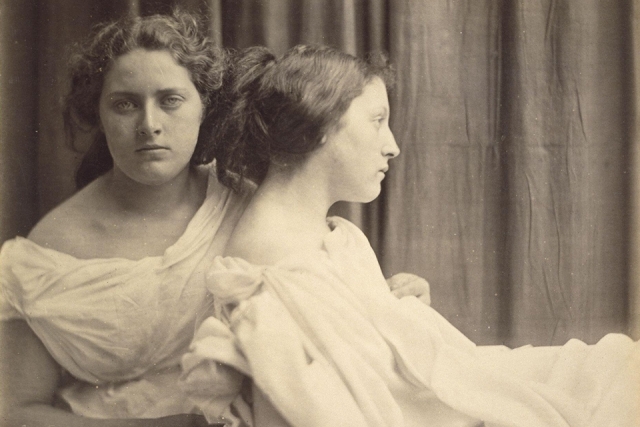
Student curators recently hosted a live, walk-through tour of a virtual art exhibition they created on the website of St. John’s University’s Dr. M.T. Geoffrey Yeh Art Gallery. The exhibit marks the third collaboratively produced St. John’s student exhibition to be curated on a virtual platform, which is quickly growing as an innovative display tool for art collections.
Custom-designed by graduate students in St. John’s Museum Administration and Public History/Library and Information Science programs, the exhibit, High Art and Hero Worship: The Photography of Julia Margaret Cameron (1815–1879), features 30 works by Ms. Cameron, a British, Victorian photographer, and examines her unconventional photography; her personal and professional relationships; and the social conventions of Victorian England and British colonialism, which influenced her pioneering work during the early years of photography.
The virtual exhibition opened on January 26—the 144th anniversary of the photograph’s death— and will remain available to the public on the Yeh Gallery website until March 21. Curated by graduate students Amanda DeLisi, Melissa Celona, Stephanie Paz, and Kristian Laureiro, who graduated in January, this is the first scholarly exhibition of Ms. Cameron’s work in nearly a decade.
“I am immensely proud of the students’ devotion to this project, including their decisive use of intensive research and new methods of exhibition-making; this allowed them to see Julia Margaret Cameron’s life and work through a contemporary lens,” said Susan Rosenberg, Ph.D., Founding Director/Coordinator, M.A. program in Museum Administration, and Professor of Art History, St. John’s College of Liberal Arts and Sciences.
This exhibition was generated in her Fall 2022 course, Introduction to Curating. Dr. Rosenberg assisted the students during the live tour on February 23, and provided commentary.
One goal of the exhibit is to take advantage of opportunities afforded by working on a digital platform, including the ability to custom design the galleries to suit their projects needs and narrative, using space, color and exhibition design.
Although Melissa has worked on curating exhibits in a physical area, the Cameron exhibition marked her first foray into working via a virtual platform. “For High Art and Hero Worship, I really appreciated the flexibility of the virtual space. The installation, which featured framed works, information labels and object labels for every exhibited photograph, meant the creative process was so much more flexible than the in-person exhibitions I had worked on in the past,” she said. “Physical spaces and the corresponding exhibition budgets can often limit the creativity of the exhibition process. Working within the virtual world circumvented physical restrictions we would have been dealing with had this exhibition been in-person.”
Curation of an art exhibit on a virtual platform, Dr. Rosenberg said, “offers students in my course maximum creativity. They devise the gallery’s architectural space and obtain an educational experience that introduces them to the many ways that professional curators use exhibition design strategies to tell stories through artifacts.”
The students focused on four key components of Ms. Cameron’s vast body of work: her photographic portraits of famous British men, including scientist Charles Darwin and poet Alfred Tennyson; her groundbreaking photographic illustrations of Mr. Tennyson’s Idylls of the King and Other Poems (1874); her late career documentary-like photographs of indigenous Ceylonese (now, Sri Lankan) people; and her work with what the artist termed as “fancy subjects,” which involved costuming family, friends, and household workers to portray figures from myth, history, and religion. Her chief inspirations, aside from the writings of Mr. Tennyson, were plays, novels, classic art and sculpture, and mythology.
Ms. Cameron’s 15-year photography career began in 1863 when she was 48. Her approach to photography was controversial at the time. Finding inspiration among painters who looked back to early Renaissance art, the photographer harnessed her medium to produce fictional—not factual—images, paving the way for 20th- and 21st-century artists’ insistence on photographs as artificial constructs—not truthful windows on the world. Ms. Cameron’s creation of staged tableaux recast photography as high art.
Exploring the life and work of Ms. Cameron, the exhibition seeks to answer the oldest photography question: How truthful can a photograph be?
Stephanie said her work on the project greatly enhanced her curation abilities. “There is so much research, writing, communication, and project management involved with creating an exhibition, that no matter your choice of career, the skills you gain from an experience like this are transferable and strengthened. I will curate on a freelance, independent basis once I graduate, and feel more than well-equipped and confident because of projects like this one.”
Said Amanda, “We put a lot of effort into collaborating and figuring out how these many-themed photographs connect. We hope this exhibition tells a full and cohesive story of Ms. Cameron’s life and works, and how they played off one another in the cultivation of her creative process and as commentary on Victorian England.”
Related News
Dean Jerrold Ross Conference Room Unveiled
On Tuesday, December 10, the newly renovated conference room on the fifth floor of Sullivan Hall was dedicated in honor of Jerrold Ross, Ph.D., former Dean of The School of Education . The renovation...
St. John’s Celebrates Holiday Season at Annual Christmas Tree Lighting and Winter Carnival
Seasonal cheer, festive music, and student enthusiasm filled the Great Lawn with anticipation on December 8 as St. John’s University community members gathered for the return of the campus Christmas Tree lighting and the climax of the 33rd annual Winter Carnival.
Vincent’s Table Brings Dignity and Support to Students Facing Food Insecurity
Food insecurity among US college students is a rising problem. About 3.8 million college students experienced food insecurity in 2020 and it has only grown steadily worse.
